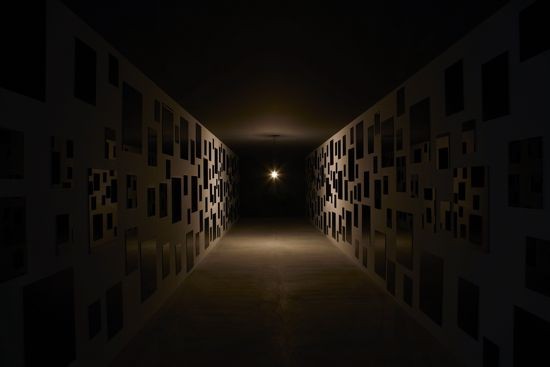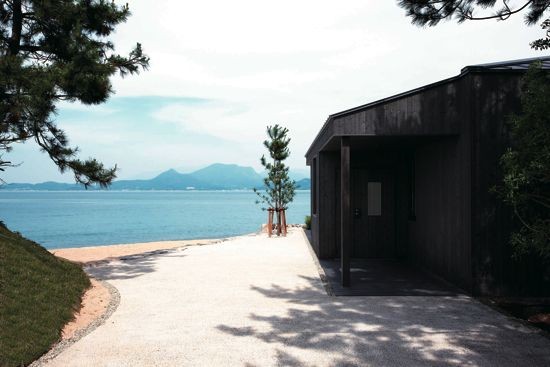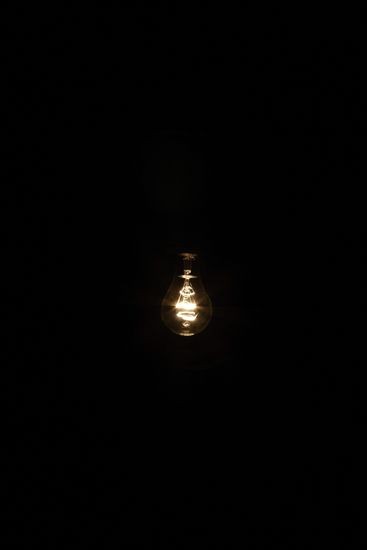Memory, too, fails at such excess
By Andrew Maerkle
 Les Archives du Coeur (2010). Photo Yasuhide Kuge, courtesy Naoshima Fukutake Art Museum Foundation.
Les Archives du Coeur (2010). Photo Yasuhide Kuge, courtesy Naoshima Fukutake Art Museum Foundation.Throughout his four-decade-long career, Christian Boltanski has explored relations between objects and memory. His installations often use materials such as found photographs, used clothing and rusted biscuit tins to trigger associations between viewers’ own personal memories and imaginary memories of the anonymous lives suggested by these objects. For example, Monument: The Children of Dijon (1986) presents photographs of young children in wall-based sculptural arrangements incorporating light bulbs, exposed wiring and framed photographs of colorful Christmas wrapping paper. Reserve: The Dead Swiss (1991) features thousands of biscuit tins stacked in columns, with a photo cut from the obituary notices of Swiss newspapers affixed to the front of each tin.
Recent works have both expanded in scale and yet moved further away from materiality. For his Monumenta 2010 commission at the Grand Palais in Paris, Personnes, Boltanksi installed rows of piled clothing in a grid extending the length of the building’s nave, and then in an apse added a 12-meter-high mountain of clothes that were repeatedly picked up and dropped by a massive automated crane. All elements of the installation were recycled after the exhibition’s conclusion, and when the work was later presented in New York at the Park Avenue Armory, it was reconstructed with new materials. Also, in late 2009 Boltanski made an unconventional agreement with the Australian art patron and renowned gambler David Walsh, whereby the artist receives a monthly payment for the next eight years to have his studio filmed by three cameras 24-hours-a-day, with the footage continuously streaming over the Internet to Walsh in Tasmania. The agreement, which took effect on January 1 of this year and has the title La vie de CB, is a bet on the artist’s longevity: if Boltanski dies within the eight-year period, Walsh will obtain the “work” at a discount, but if he survives beyond that period Walsh will pay the artist an even higher fee.
Boltanski was recently in Japan for the opening of the Setouchi International Art Festival, where a permanent home for another project, Les Archives du Coeur (The Heart Archive), was unveiled on the island of Teshima in the Seto Inland Sea. Since 2005, Boltanski has been collecting recordings of the heartbeats of thousands of people who have visited his exhibitions. On Teshima the archive is contained in a purpose-built single-story structure overlooking the sea. Visitors entering the structure are first greeted by computer screens relaying data about the heartbeats that are being played in a subsequent room, which resembles a narrow hallway and is illuminated by a single, flickering light bulb, its walls adorned with framed black panels of various sizes. Visitors then proceed to another room with a searchable database of all the heartbeats in the archive, and then to a final room where they have the option of paying to have their own heartbeats recorded.
ART iT met with Boltanski to discuss his Heart Archive project, his bet with David Walsh, his plans for the France Pavilion at the 2011 Venice Biennale and how his ideas about the archive have changed with the popularization of the Internet.
 Les Archives du Coeur (2010). Photo Yasuhide Kuge, courtesy Naoshima Fukutake Art Museum Foundation.
Les Archives du Coeur (2010). Photo Yasuhide Kuge, courtesy Naoshima Fukutake Art Museum Foundation.ART iT: Throughout your career you have often addressed through your works the idea of the archive. Now that the Internet has become a kind of universal archive, has it altered how you conceive your works?
CB: I think the Internet is incredibly important for the future, but with its excess of information it’s also a little dangerous.
It would have been very easy to upload the Heart Archive project to the Internet, but I preferred the idea of putting the work in Teshima, so that people must travel to experience it, and maybe think about it as they travel, maybe anticipate what kind of heartbeats they will hear.
I think the beauty of the Internet is that it can connect so many people, and you can be in two places at the same time. I am actually using this aspect of the Internet for my current project streaming video from my studio in France to the collector David Walsh in Tasmania. I had long wanted to make a show in a gallery in which I would actually be at my studio the whole time and people would go to the gallery to see me making new works, but the works themselves would not be there. And then someone could buy an hour in the life of Christian Boltanski for example, and during that time I would be doing something.
But in terms of the Internet as an archive, if I search “Christian Boltanski,” there will be something like 20,000 results [172,000 results, in fact], which is totally ridiculous because nobody can read all of them, nobody can understand what they mean, and if you read them, half are wrong, but you don’t know which are right and which are wrong.
ART iT: Isn’t that uncertainty also a mechanism in your installation works using biscuit tins filled with information that nobody else can access?
CB: For me the idea has always been about hiding something – hiding information and having viewers understand that the information is there, but hidden. The difference with the Internet is that nothing is hidden; everything is given. It’s beautiful for this reason, but perhaps a little dangerous because there is no mystery anymore.
ART iT: You also use found photographs in your works, so has the Internet changed your relationship with images, to the extent that they are no longer physical?
CB: Yes. If I want a photo of Buenos Aires it’s right at my fingertips, whereas before it was difficult to find. Because finding images on the Internet is so easy, you have to know what you want to do with them.
I was actually planning to use the Internet for my presentation in the France Pavilion at next year’s Venice Biennale. I was going to make a very large map of the world with red and blue lights over every city. When somebody dies somewhere a blue light would flash over that location, and when somebody is born a red light would flash. But it’s not possible because I think something like two people die and four people are born every second, so the map would be constantly lit. I found a website that counts the number of people who die and you see the numbers escalating every second – it’s so quick. Of course these are statistical projections and not actual deaths, but I am still thinking about how to address the representation of birth and death for Venice.
 Les Archives du Coeur (2010). Photo Yasuhide Kuge, courtesy Naoshima
Les Archives du Coeur (2010). Photo Yasuhide Kuge, courtesy Naoshima Fukutake Art Museum Foundation.
ART iT: In that sense your work has often addressed – sometimes directly and sometimes indirectly – the idea of the Holocaust.
CB: It’s true and it’s not true. It’s true that the Holocaust has been important for me personally, and also because such a large number of deaths occurred. What’s strange for me with the Holocaust is that I can imagine 1,000 deaths, but I really can’t imagine six million. I believe it’s also something that could equally apply to Hiroshima or elsewhere.
ART iT: But if we consider death as a metaphor, perhaps the Holocaust anticipates the Internet in showing us this kind of new volume achieved by technology.
CB: What you say is very interesting because the volume is very important for me. That was the idea behind the installation I just did for the Monumenta project at the Grand Palais in Paris, Personnes (2010), with the piles of used clothing. To kill somebody is certainly terrible, but what is even more terrible is to erase that person’s name. In the Nazi death camps the victims had their names taken away and replaced by numbers, and for me that is the truly terrible aspect of what happened.
There’s another piece I did that is in a way related to the Internet, Les Abonnés du Téléphone (2000), for which I collected thousands of telephone books from around the world and installed them in a small room. The installation contains something like 600,000 names, although of course now the telephone books are obsolete because all the information is on the Internet. But I envision this piece as a kind of library of all the people who were living on Earth at a given time.
In my work there’s always this idea of uniqueness in big numbers. So even if I were able to assemble all the heartbeats in the world in my Heart Archive, it would be one unique heartbeat after another, and even if all the heartbeats seem very similar to each other, there would always be something individual within the collective.
ART iT: Your early works reconstructing your childhood as well as your mail-art projects seemed to operate on a much more intimate or personal scale. When did you start to think in more expanded, universal terms?
CB: I think I have always been concerned about the idea of disappearance. At first I was concerned about the idea of my childhood disappearing. Then there was a second period, which dealt with collective memory. And now there is a third period in which I have returned to my own memory.
In any case my goal is always to preserve memory, but I always fail. As with the Internet, you can have thousands and thousands of documentation, but that won’t actually add up to a real person. I think in a way what I try to do and what the Internet tries to do is to resist god, but it’s impossible.
ART iT: So you compare yourself to the Internet?
CB: In a way I do, because I want to preserve and accumulate memory. For example I have made books like Archive of the Carnegie International 1896-1991 filled only with names, and in my studio I have so many archives, including maybe 7,000 photos of dead Swiss people, and in Teshima we already have something like 16,000 heartbeat recordings, but what we actually have is only the spirit, not the actual people. Ultimately I am unable to protect anybody. One of the motivations of my work is to show that in fact we can’t protect anything. We can have a lot of information and we can continue to add to that information but we can’t preserve life. And the more information you have about somebody the more you feel that person’s absence. That’s the problem with numbers.
When I’m in Paris or Tokyo and I look at the streets there are so many people, and each person has their own life and story, and each person would be marvelous to know, but it’s impossible – there’s no time. I made a piece four or five years ago, Prendre la Parole (2005), which was an installation of simple plywood constructions with clothes hung on them to resemble people. There were around 40 of them, and each one had an audio component as well. So one of them says, “I’m happy,” another says, “I work a lot,” or “I’m clever,” each one says something different. And I think that is what interests me. Everybody looks more or less similar, but everybody is unique.
With the Internet we can take that even further. I was very happy to discover one day these websites with girls that you can interact with through video cameras, and you know that it is indirect but there are thousands and thousands of these girls and if you pay a little more you can ask them to do things for you, although I never went that far. What interests me is that you never know where these girls actually are. Maybe in the morning they are in China and then in the evening they are in Argentina, but there is no real way to identify them. So you can interact with them but at the same time know nothing about them. That was fascinating to me.
And from there I imagined somebody who might be in love with a girl, and knows that she exists somewhere, but can’t find her. I imagined it to be something very beautiful to see this girl everyday and be in love with her, but with no way of reaching her. And then sometimes this lover could say, “Oh, it must be sunny where you are because I can see your window,” or “It must be nighttime because it’s dark.” I found the idea very beautiful and wanted to make a piece about it, but in the end I couldn’t find a way to realize it. This was last summer. And now I can no longer find the same girl with whom I was communicating. It’s impossible, totally lost.
 Les Archives du Coeur (2010). Photo Yasuhide Kuge, courtesy Naoshima Fukutake Art Museum Foundation.
Les Archives du Coeur (2010). Photo Yasuhide Kuge, courtesy Naoshima Fukutake Art Museum Foundation.ART iT: Well, the volume of pornography on the Internet is also staggering. Thinking about the volume of death and the volume of pornography reminds me of your works with found images. Do you conceive of the anonymous photograph as a conceptual sculpture in the sense that it represents the surface of an unknown volume?
CB: In fact for a long time I have regarded dead bodies, photographs and clothes in the same light. They are objects that are related to subjects that are absent. When you have a photo of somebody you can pick it up – it’s an object – but it’s in relation to an absent subject. If you have a used coat, it’s also an object in relation to an absent subject. If you have a dead body, it’s also an object in relation to an absent subject.
ART iT: So more precisely we might say it’s not an unknown volume but a negative volume?
CB: Yes. It’s like the heartbeats: there was somebody. There was somebody, and now we have an object, but we can destroy it if we want, because it’s only an object. And if you speak about the Holocaust, there’s always this idea with the Nazis that they were dealing not with people but with objects. The Nazis always said, “Today we have 20 tons of material arriving.” It was never “1,000 people,” it was always “X tons of material.” That was the terminology. And for me it’s true that this relation between object and subject is very important, as is the relation between the name and the person. I can imagine a scenario where someone says, “We’re going to war but it won’t be so bad, only 1,000 people will die and that’s not so many.” But it’s not 1,000 people, it’s one who loved spaghetti, one who had a girlfriend, one who loved football, it’s always one plus one plus one. Democracy itself must be one plus one plus one, and if you quantify a group of people into a lump sum it becomes very dangerous. One of my major concerns is that I really believe that everybody is both very important and yet very fragile, and after two or three generations, everybody will be forgotten.
What I do with my art is show that it’s impossible to protect something completely. Now for this piece in Tasmania what I am doing is speaking about the fact that I’m dying, and accepting the fact I’m dying. The collector David Walsh is like a computer in a way – and he may actually be able to calculate faster than a computer – because he believes that he cannot lose. The real idea of the piece is to say, I hope to win, but perhaps I am going to lose. It’s only a question of time. If you see a baby on the street, even that baby will die some day. For me it is very important to speak about that and to not refute it. If I survive Walsh will be filming me in my studio and I will grow older and older, and maybe I will need a staircase, or perhaps one day I will need someone to carry me up that staircase. That’s life.
The Setouchi International Art Festival continues at multiple venues through October 31.
Related:
New Festival Brings Art, Architecture to Inland Sea
